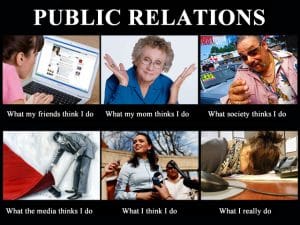
A lot of people misunderstand what public relations is and how it is used. Continue reading to find out what goes into being a publicist and how your small business can benefit from it.
If someone were to approach you and ask, “What is public relations and what does a publicist do?” – How would you answer? Would any of the images to the right from Memesuper.com come to mind? It is surprising how often people misunderstand what I do as a publicist day in and day out to help my clients reach their goals and get their brand the media recognition they deserve. Being a successful publicist takes a lot of work and knowing how to use the tools of the trade effectively. April marked my one year anniversary with Three Girls Media, and it’s a perfect time to reflect and share helpful lessons on how small businesses can use public relations to be your own publicist!
Public Relations Tools of the Trade:
Public Relations is more complex than spamming journalists with useless information about products that don’t fit their beat. Publicists use a few tried and true tools to reach the media and get brands editorial exposure.
- Electronic Press Kits
An electronic press kit (EPK) is a place where the media can go to get all the information they need about a business or brand; it’s a one-stop shop for the press. When writing your press kit, the language should be clear and to the point – there is no need to include fluff and extra details in this document. As you put together an EPK for your brand, consider the “5 W’s”- Who, What, When, Where and Why (or How). These prompts will help you include all the most important information that the press will be looking for. A don’t forget to place a few high-resolution photos of your products that the media can download as well!
- Media Lists
A media list is exactly what it sounds like: a list of media personnel you want to contact about your brand, product or service. Media list building is one of the most tiresome, yet important activities a public relations professional performs; without a solid list, your efforts to try to secure editorial coverage for your small business are completely wasted.
So how do you build a media list? When thinking of your brand, where would you like to see it featured? The first step is to write down these outlets. You can even Google “Parenting Magazines” or “Women’s Websites” if you need a starting point and can’t think of publications off the top of your head.
From there, research which journalists in particular cover what you have to offer. For example, pretend your business offers men’s skincare and grooming products. Find out who writes about men’s interests, and then see if they have previously featured items similar to yours and if your brand fits their content. If the publication or journalist doesn’t align well with your offerings, cross it off the list. Sending a pitch to an outlet that is not a strong fit can have a negative effect on your attempts to get coverage.
A completed list will include the name of the journalist, reporter or writer, the outlet they work for, contact information and any other important notes you have learned about the person and their communication preferences. Once you have found the right people, now is the time to find out how to reach them, preferably by email.
- Pitching vs Press Releases
A media list means nothing if you don’t have something to send. This is where the publicists use the next tool in their arsenal, a pitch letter or a press release.
Emily Sidley, Three Girls’ Senior Director of Publicity, explains beautifully the major differences between press releases and pitches. “A pitch letter is a suggested story idea that’s submitted to individual journalists via email. It gives the reporter an idea for a story that they could write. If the journalist likes the idea and their editors approve, they then write a story for their media outlet based on the suggestion.
A press release is generally longer than a pitch and provides details of

Do you know the difference between a pitch and press release and when to use them? Check out this great explanation!
something newsworthy. Newsworthy is key here. You can write a pitch about a fantastic line of makeup, but unless the makeup is made by a major brand and has a phenomenal new feature (e.g. is made from recycled plastic) it just isn’t worthy of a full release.”
Check out this article from Three Girls’ CEO and Founder, Erika Taylor Montgomery, in the Bulldog Reporter explaining in more detail about how to differentiate and when to use these two editorial tools.
Now that you know the difference between the two media devices, make sure to put the most significant information at the very top of your release or letter. Let the reporter know right away why you are writing to them, and what makes your brand different or why the news you have is important to them and their readers.
- Editorial Calendars
Simply put, an editorial calendar allows effective planning and strategic follow up for content and interaction with a reporter. A media outlet’s editorial calendar paints the big picture for bloggers and journalists as they write articles throughout the year so they know what issues are coming up and can write stories that align with the overall themes. By looking at a media outlet’s editorial calendar, you can see what topics and themes they have planned for the year and time when you pitch your brand as part of the story they’re already working on telling.
- Content Calendars
As a publicist for Three Girls, my job entails more than reaching out to the media on behalf of my clients. A big part of my responsibilities include creating content (like this blog post) and managing social media accounts, which can support the message and story you’re pitch to the media. As the world becomes more digital, content creation continues to be an important part of your public relations strategy.
How do content calendars help? Similarly to editorial calendars, these tools map out and plan what you are going to post on your social media channels and blogs. In fact, you can include your media pitching plans in your content calendar as well to help you keep track of all your PR activities in one place.
Begin by writing down all of your ideas; include topics and themes as well as relevant dates and events that could correspond with special postings (e.g. product releases, special events, holidays, seasonal changes, etc). Having your annual or seasonal events and activities written in one place will promote continuity when creating content for your readers throughout the year. Once you have all the important spots filled, you can begin creating and finding other industry related topics to place in the empty spots. After you have organized your thoughts on paper it is much easier to create a plan and a schedule for posts.
Public Relations and Customer Service
One of the most overlooked pieces of public relations has to be the customer service aspect. From managing the expectations, anticipating needs and being able to supply the appropriate level of attention for both the client and the media.
- Managing Expectations. One thing I have come to learn as a publicist is that you can’t guarantee specific coverage; this is important for clients, and small business owners, to understand. You can do everything right, from building a well thought out media list to coming up with a catchy personal pitch, and you can still end up with zero response; that’s a tough pill to swallow. In the end it is up to the media contacts to decide if they want to pursue your brand. If the media does bite, it is our responsibility to promote the product with honesty and professionalism.
-

Customer Service and relationship building is an import part of public relations and small business success.
Anticipating Needs. In public relations, my clients are my customers. Whether there is an event coming up, a new product being launched, or even room for improvement in the current scope of work, my job is to anticipate how these changes can affect their campaign so I can assist in my client’s success. When working with the media I have to be prepared to answer questions, supply details and photos, and arrange for samples to be sent or interviews scheduled. It’s worth it to take the extra time to anticipate needs and plan to have everything ready to go right away when it’s requested!
- Appropriate Levels of Attention. It can be a balancing act to provide enough details to answer questions, but not so much that you overwhelm a client or media contact. It’s important to really listen to what they’re saying – beyond just the words they use – so you can provide them with everything they are looking for.
- Show Your Appreciation. Nothing shows how much your customers mean to you than sending a hand written thank you note for their purchase or visit. Taking the extra time to acknowledge your visitors can make all the difference and you’ll be sure to stick out in their mind the next time they need something. At Three Girls, we make sure to send a thank you card to reporters and journalists for taking the time to including our clients in their outlet. This simple act is a great relationship builder and takes no time at all.
Flexibility in Public Relations
Things can change in a blink of an eye in public relations, from breaking news to a shift in focus on what is being worked on. As a small business owner or entrepreneur, this is not a shocking realization for you, I’m sure. How do you respond to sudden changes in your plans?
I have learned it makes life much more enjoyable to go with the flow and expect the unexpected. It doesn’t mean always dropping everything you’re doing. It is important to understand when a new, sudden task is due so you can re-evaluate your priorities and adjust your schedule accordingly. Along the same lines, don’t wait until the last minute to complete a task like creating an EPK, media list or pitch letter. By completing work early you give yourself more breathing room when an unforeseen event does come along. Effective time management and flexibility are the keys to successfully handling sudden changes.
How have you and your business grown in the last year, and what knowledge can you share with us? It is amazing how fast 365 days go by and what you can learn in that span of time. No matter what industry you’re part of, hopefully this insight will help you in your future business and PR endeavors!
Check out these other great articles to learn more about public relations!
- Choosing a Public Relations Agency: Small Business Tips
- [Media Relations] Common Pitching Mistakes and Simple Fixes
- Free Guide: What is a Press Release, Media Pitch & More?
